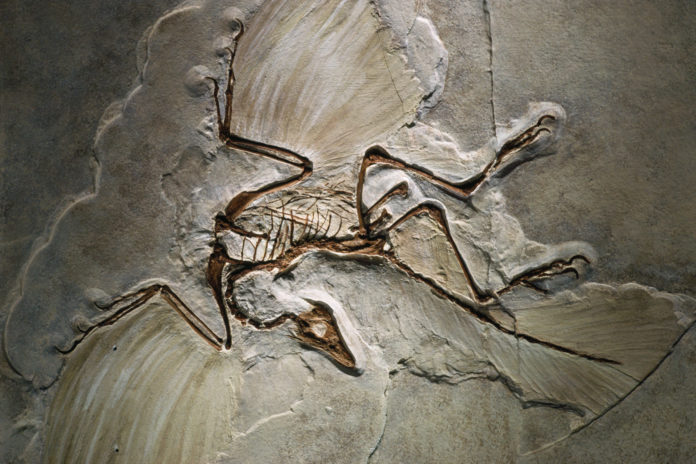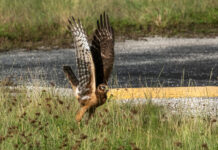Are birds really just fancy little dinosaurs? — Bi-Residential Barry
Yes! Yes, they are.
I started to write about how all the birds we know can be traced to one ancient genus called archaeopteryx. They were these feathered dinosaur things, about the size of a crow, that could probably sorta fly.
I mean, the whole point of doing an “Ask the Bird Geek” column is to answer a couple of quick bird questions off the top of my head without doing a lot of research. Because I’m trying to go on vacation. Because it’s been a long pandemic and I really need to go on a vacation road trip. Like, I really, really need to go on a vacation road trip. Other than last night, when I dreamed about being sentenced to 40 days in a low-security jail because I took an inappropriate photo of a duck, I have dreamed for months about nothing but eating at a Waffle House.
But then I started questioning myself. Are you sure you’re providing the most up-to-date and accurate information here? What if, as The Dude says in “The Big Lebowski,” new facts have come to light, man? There’s an old saw about the first rule of journalism: If your mother says she loves you, check it out, i.e., always make sure what you believe to be true is true. (And sure, this column passes for journalism.)
So I did some reading.
The first archaeopteryx fossils were found in Germany in the mid-1800s. (The Germans gave them the name Urvogel, which is a sexy word to say if you haven’t eaten dairy recently.)
For a long time archaeopteryx was thought to be the missing link – the evolutionary through-line between the velociraptor crowd and the bluebird crowd.
But then in the early 2010s, a fossil called Xiaotingia zhengi was found in China, and one called Epidexipteryx hui was found in Mongolia. Thoughtful, sophisticated and complex papers were written saying that these were, in fact, the closest ancestors to modern birds, and that archaeopteryx was just a dead end, broken-off branch of the evolutionary tree. But then someone else wrote an even more thoughtful, sophisticated and complex paper, incorporating detailed study of Xiaotingia zhengi and Epidexipteryx hui and several other more recently discovered fossils, and said, wait, no, archaeopteryx, a.k.a the Urvogel, is still the closest ancestor we have to living birds.
Someone once told me that if you want to see scientists yell at each other, go to an evolutionary paleontology conference. That being said, the one thing all these people would agree on is that birds are, really, just fancy little dinosaurs.
If you want to read more about this, I’ll post a link to a much more clearly written story from the Live Science site at markhedden.com/notes.
(At the end of this sentence I will be 501 words closer to eating at a Waffle House.)
If birds are dinosaurs, how did they survive extinction? — Andy Who Will Not Share His Tonic Water Recipe
It’s been 65 million years and they (the birds) still refuse to answer the question.
Scientists have been coming up with some interesting theories, though. The one considered most plausible is that the meteor that hit at the end of the Cretaceous period wiped out all the trees and forests, thus putting an end to any forest-dependent communities. Those forests were (relatively) quickly replaced by fern communities. The birds and proto-birds that survived were the ground dwellers that could adapt quickly, the predecessors to ducks, chickens, and ostriches.
Who’s the most famous bird you ever met? — Deputy Devers
Back in the 1970s, when I was attending kindergarten in the basement of St. Luke’s Episcopal Church in Hudson, Massachusetts, we were told we would be having a very special visitor. And then, slowly down the stairs, led by the hand/wing by one of the teachers, came this giant, yellow creature, with a long, conical yellow bill and a big set of googly eyes. He seemed mostly concerned with trying not to bump his head on the low ceiling. This was in the early days of “Sesame Street,” when Big Bird’s fame was somewhat nascent. Still, the room erupted. Sure, two or three kids cowered and wailed in fear against the wall with the “Jesus Loves the Little Children” mural. But for everyone else, it was like the Beatles at Shea Stadium. Lots of shrieking, lots of joyous running around, lots of hugging his legs, lots of yellow feathers drifting through the air. For everyone else but me, anyhow.
Because even then, surrounded by all that chaos, I knew something wasn’t right, that something was fishy in the place my father called Taxachusetts. It took a little while to hone in on it – possibly years, if you believe my therapist – but it was the legs. The real Big Bird, the one on the TV, had orange legs with these intermittent purple rings running down them – a unique ornithological characteristic. The legs of the bird in that basement? They were pure yellow, looking less like bird legs than human legs in yellow pantyhose.
This was the moment that galvanized everything that was right and wrong about me. Sure, there was the now innate mistrust of all adults, including the one I would one day become. But also the strong, undeniable imperative to look at a bird and know exactly by what name it should be called.
Somewhere in the dark well of my soul, I cling to the belief that the one, true Big Bird is out there, waiting to meet me, to say in his soothing, slightly adenoidal voice, “Hello, Mark. Hello.” As the years pass, though, I know this is less and less likely to come true.
Thank you for bringing up this painful memory. I will be leaving the island for several weeks to recuperate.
Got a bird question you’re dying to ask, or even just mildly curious about? Email ‘Ask the Bird Geek’ at mark@markhedden.com.























